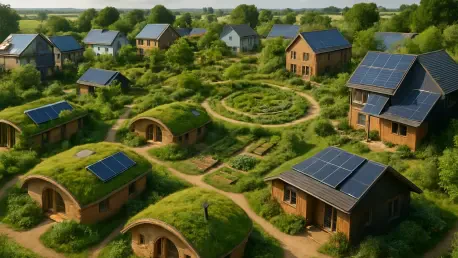In the heart of the East Midlands, just outside Nottingham, a transformative vision is taking shape on a sprawling 606-acre site known as Fairham, capturing attention as one of the region’s most significant projects. This ambitious mixed-use development promises to redefine community living through a careful balance of residential, commercial, and recreational spaces. At the core of this endeavor lies a critical phase of earthworks, meticulously executed to lay the foundation for thousands of homes and expansive employment areas. Far beyond mere construction, the efforts at Fairham represent a commitment to sustainability and interconnected living, aiming to create a neighborhood where people can thrive in harmony with their environment. As progress accelerates, the impact of these groundwork operations offers a glimpse into how thoughtful planning and execution can address modern housing demands while prioritizing long-term ecological and social benefits. This exploration delves into the pivotal role of earthworks in shaping Fairham’s vision.
Laying the Groundwork for a Visionary Community
The current phase of earthworks at Fairham, spearheaded by a dedicated contractor team in collaboration with key development partners and government bodies, marks a crucial step in preparing the site for its next chapter. This extensive operation involves a range of tasks, from stripping and relocating topsoil to executing precise cut-and-fill activities that reshape the landscape. Additionally, the creation of attenuation ponds to manage water flow, initial groundwork for sports pitches, and the sculpting of open spaces for future landscaping are all underway. These efforts, part of a substantial £100 million infrastructure investment, are designed to ensure that the land is ready for the construction of vital elements like roads and sewers. The scale of this preparation underscores the project’s ambition to deliver not just buildings, but a cohesive environment where infrastructure supports sustainable living from the ground up, setting a robust foundation for the community’s growth.
Beyond the technical aspects, the earthworks at Fairham symbolize a broader commitment to transforming raw land into a vibrant hub of activity. The focus extends to unlocking significant parcels for residential development, with plans for 3,000 homes alongside over one million square feet of employment space. This phase is pivotal, as it enables the subsequent rollout of essential amenities and green areas, ensuring that the development meets the diverse needs of future residents and businesses. Moreover, coordination with local authorities and national transport entities ensures that infrastructure improvements integrate seamlessly with existing networks, minimizing disruptions. The meticulous planning behind these operations reflects a dedication to creating a space that balances growth with accessibility, positioning Fairham as a model for how large-scale projects can prioritize both immediate functionality and long-term community well-being in their foundational stages.
Building Sustainability into the Core of Development
Sustainability lies at the heart of Fairham’s design, with the earthworks phase playing an integral role in embedding eco-friendly principles into the project’s fabric. The creation of 200 acres of green open spaces, alongside features like attenuation ponds for natural water management, demonstrates a forward-thinking approach to environmental stewardship. These elements are not mere afterthoughts but are being shaped now, during the groundwork stage, to ensure they support the ecosystem as the community grows. Plans for educational and healthcare facilities, a local center, and even a reserved route for a potential tram extension further illustrate how the development aims to reduce reliance on cars and promote sustainable transport options. By integrating these components early through careful earthworks, Fairham is poised to offer a lifestyle that minimizes environmental impact while enhancing quality of life for its inhabitants.
Equally important is the economic sustainability that Fairham seeks to foster, with the earthworks enabling the infrastructure needed to support thousands of jobs and homes. This aligns with regional goals, such as Rushcliffe Borough Council’s target of delivering 13,500 new dwellings by 2030, positioning the project as a key contributor to local growth. The strategic location near Nottingham enhances its potential as an economic driver, connecting residents to broader opportunities while maintaining a distinct community identity. As the earthworks progress, they lay the literal and figurative groundwork for a development that prioritizes long-term viability, ensuring that future phases of construction can build on a stable, well-planned base. This focus on integrating economic and environmental priorities highlights Fairham’s role as a benchmark for modern urban planning, where sustainability is not just a goal but a guiding principle from the earliest stages of development.
Reflecting on Milestones and Future Horizons
Looking back, the strides made in the earthworks at Fairham stand as a testament to collaborative effort and strategic vision. The completion of critical tasks like topsoil management and landscape shaping marks significant progress, unlocking land for housing and setting the stage for a thriving community. Supported by substantial infrastructure investments, these efforts showcase how meticulous preparation can pave the way for sustainable growth in the East Midlands. The partnership between developers, contractors, and local stakeholders has proven instrumental in navigating challenges, ensuring that each step aligns with the overarching goal of creating a balanced, interconnected neighborhood. As this phase wraps up, it leaves behind a solid foundation for the next stages of construction, reflecting a commitment to both immediate results and enduring impact. Moving forward, attention should shift to leveraging these achievements by accelerating the rollout of residential and commercial spaces while continuing to prioritize green initiatives and community connectivity.









